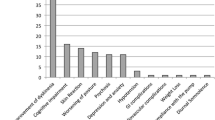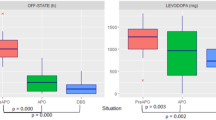Abstract
Continuous apomorphine infusion (APO) is one of the treatments available for advanced Parkinson disease (PD). Over 10 years, we have treated 230 patients with APO. Mean age was 66.8 and average evolution time at APO onset was 13.0 years. Mean duration of the treatment was 26.3 months. As of June 2016, 93 remained on the medication (active group), while 137 had stopped. This active group had mean age 67.3 at recruitment and mean evolution 14.2 years. The main indication for APO was lack of deep brain stimulation criteria (DBS). Twelve patients were on waiting list for DBS. Average time since APO onset was 40.0 months. In the active group, APO decreased off-state in 4 h and allowed reducing levodopa and dopamine agonists. Dyskinesia and balance did not worsen. Cognitive decline did not change within the first 15 months. Hallucinations were the same within the first 39 months. The presence of subcutaneous nodules was the most frequent adverse event in this group. The main reason for discontinuation was side effects, being psychosis the most common. Within the first year, 82 patients stopped APO. Eighteen of these patients eventually got DBS. APO is a good option for advanced PD, since it permits a significant reduction in off-time and other antiparkinsonian drugs. This effect is sustained over time. We have treated 132 patients for over a year. Dyskinesia seems not to worsen. Combining APO with DBS simultaneously or alternatively provides good results.






Similar content being viewed by others
References
Unti E, Ceravolo R, Bonuccelli U (2015) Apomorphine hydrochloride for the treatment of Parkinson’s disease. Expert Rev Neurother 15:723–732. doi:10.1586/14737175.2015.1051468
Defer GL, Widner H, Marié RM, Rémy P, Levivier M (1999) Core assessment program for surgical interventional therapies in Parkinson’s disease (CAPSIT-PD). Mov Disord 14:572–584
Gelb DJ, Oliver E, Gilman S (1999) Diagnostic criteria for Parkinson’s disease. Arch Neurol 56:33–39
R Core Team (2014). R: A language and environment for statistical computing. R Foundation for Statistical Computing, Vienna, Austria. http://www.R-project.org/.
Jiang J (2007) Linear and generalized linear mixed models and their applications. Springer, New York. doi:10.1007/978-0-387-47946-0
Pinheiro JC, Bates DM (2000) Mixed-effects models in S and S-PLUS. Springer, New York. doi:10.1007/b98882
Fernández-Pajarín G, Sesar A, Ares B, Castro A (2016) Evaluating the efficacy of nocturnal continuous subcutaneous apomorphine infusion in sleep disorders in advanced Parkinson’s disease: The APO-NIGHT study. J Parkinsons Dis 6:787–792. doi:10.3233/JPD-160886
Storch A, Schneider CB, Wolz M, Stürwald Y, Nebe A, Odin P, Mahler A, Fuchs G, Jost WH, Chaudhuri KR, Koch R, Reichmann H, Ebersbach G (2013) Nonmotor fluctuations in Parkinson disease: severity and correlation with motor complications. Neurology 80:800–809. doi:10.1212/WNL.0b013e318285c0ed
Zhang G, Zhang Z, Liu L, Yang J, Huang J, Xiong N, Wang T (2014) Impulsive and compulsive behaviors in Parkinson’s disease. Front Aging Neurosci 6:318. doi:10.3389/fnagi.2014.00318
Todorova A, Chaudhuri KR (2013) Subcutaneous apomorphine and non-motor symptoms in Parkinson’s disease. Parkinsonism Relat Disord 19:1073–1078. doi:10.1016/j.parkreldis.2013.08.012
Trenkwalder C, Chaudhuri KR, García Ruiz PJ, LeWitt P, Katzenschlager R, Sixel-Döring Henriksen T, Sesar Á, Poewe W (2015) Expert Consensus Group report on the use of apomorphine in the treatment of Parkinson’s disease—Clinical practice recommendations. Parkinsonism Relat Disord 21:1023–1030. doi:10.1016/j.parkreldis.2015.06.012
Obeso JA, Grandas F, Vaamonde J, Luquin MR, Martínez-Lage JM (1987) Apomorphine infusion for motor fluctuations in Parkinson’s disease. Lancet 13:1376–1377
Hughes AJ, Bishop S, Kleedorfer B, Turjanski N, Fernandez W, Lees AJ, Stern GM (1993) Subcutaneous apomorphine in Parkinson’s disease; response to chronic administration for up to 5 years. Mov Disord 6:165–170. doi:10.1002/mds.870080208
Stocchi F, Vacca L, De Pandis MF, Barbato L, Valente M, Ruggieri S (2001) Subcutaneous continuous apomorphine infusion in fluctuating patients with Parkinson’s disease: long-term results. Neurol Sci 22:93–94
Manson AJ, Turner K, Lees AJ (2002) Apomorphine monotherapy in the treatment of refractory motor complications of Parkinson’s disease: long-term follow-up study of 64 patients. Mov Disord 17:1235–1241. doi:10.1002/mds.10281
Morgante L, Basile G, Epifanio A, Spina E, Antonini A, Stocchi F, Di Rosa E, Martino G, Marconi R, La Spina P, Nicita-Mauro V, Di Rosa AE (2004) Continuous apomorphine infusion (CAI) and neuropsychiatric disorders in patients with advanced Parkinson’s disease: a follow-up of two years. Arch Gerontol Geriatr Suppl 9:291–296. doi:10.1016/j.archger.2004.04.039
Tyne HL, Parsons J, Sinnott A, Fox SH, Fletcher NA, Steiger MJ (2004) A 10 year retrospective audit of long-term apomorphine use in Parkinson’s disease. J Neurol 251:1370–1374. doi:10.1007/s00415-004-0547-4
Katzenschlager R, Hughes A, Evans A, Manson AJ, Hoffman M, Swinn L, Watt H, Bhatia K, Quinn N, Lees AJ (2005) Continuous subcutaneous apomorphine therapy improves dyskinesias in Parkinson’s disease: a prospective study using single-dose challenges. Mov Disord 20:151–157. doi:10.1002/mds.20276
De Gaspari D, Siri C, Landi A, Cilia R, Bonetti A, Natuzzi F, Morgante L, Mariani CB, Sganzerla E, Pezzoli G, Antonini A (2006) Clinical and neuropsychological follow up at 12 months in patients with complicated Parkinson’s disease treated with subcutaneous apomorphine infusion or deep brain stimulation of the subthalamic nucleus. J Neurol Neurosurg Psychiatry 77:450–453. doi:10.1136/jnnp.2005.078659
García Ruiz PJ, Sesar Ignacio A, Ares Pensado B, Castro García A, Alonso Frech F, Alvarez López M, Arbelo González J, Baiges Octavio J, Burguera Hernández JA, Calopa Garriga M, Campos Blanco D, Castaño García B, Carballo Cordero M, Chacón Peña J, Espino Ibáñez A, Gorospe Onisalde A, Giménez-Roldán S, Granés Ibáñez P, Hernández Vara J, Ibáñez Alonso R, Jiménez Jiménez FJ, Krupinski J, Kulisevsky Bojarsky J, Legarda Ramírez I, Lezcano García E, Martínez-Castrillo JC, Mateo González D, Miquel Rodríguez F, Mir P, Muñoz Fargas E, Obeso Inchausti J, Olivares Romero J, Olivé Plana J, Otermin Vallejo P, Pascual Sedano B, de Colosía Pérez, Rama V, Pérez López-Fraile I, Planas Comes A, Puente Periz V, Rodríguez Oroz MC, Sevillano García D, Solís Pérez P, Suárez Muñoz J, Vaamonde Gamo J, Valero Merino C, Valldeoriola Serra F, Velázquez Pérez JM, Yáñez Baña R, Zamarbide Capdepon I (2008) Efficacy of long-term continuous subcutaneous apomorphine infusion in advanced Parkinson’s disease with motor fluctuations: a multicenter study. Mov Disord 23:1130–1136. doi:10.1002/mds.22063
Antonini A, Isaias IU, Rodolfi G, Landi A, Natuzzi F, Siri C, Pezzoli G (2011) A 5-year prospective assessment of advanced Parkinson disease patients treated with subcutaneous apomorphine infusion or deep brain stimulation. J Neurol 258:579–585. doi:10.1007/s00415-010-5793-z
Martinez-Martin P, Reddy P, Antonini A, Henriksen T, Katzenschlager R, Odin P, Todorova A, Naidu Y, Tluk S, Chandiramani C, Martin A, Chaudhuri KR (2011) Chronic subcutaneous infusion therapy with apomorphine in advanced Parkinson’s disease compared to conventional therapy: a real life study of non motor effect. J Parkinsons Dis 1:197–203. doi:10.3233/JPD-2011-11037
Borgemeester RW, Drent M, van Laar T (2016) Motor and non-motor outcomes of continuous apomorphine infusion in 125 Parkinson’s disease patients. Parkinsonism Relat Disord 23:17–22. doi:10.1016/j.parkreldis.2015.11.013
Martinez-Martin P, Reddy P, Katzenschlager R, Antonini A, Todorova A, Odin P, Henriksen T, Martin A, Calandrella D, Rizos A, Bryndum N, Glad A, Dafsari HS, Timmermann L, Ebersbach G, Kramberger MG, Samuel M, Wenzel K, Tomantschger V, Storch A, Reichmann H, Pirtosek Z, Trost M, Svenningsson P, Palhagen S, Volkmann J, Chaudhuri KR (2015) EuroInf: a multicenter comparative observational study of apomorphine and levodopa infusion in Parkinson’s disease. Mov Disord 30:510–516. doi:10.1002/mds.26067
Wenzel K, Homann CN, Fabbrini G, Colosimo C (2014) The role of subcutaneous infusion of apomorphine in Parkinson’s disease. Expert Rev Neurother 14:833–843. doi:10.1586/14737175.2014.928202
Author information
Authors and Affiliations
Corresponding author
Ethics declarations
Conflicts of interests
AS has received honoraria from Britannia/Italfarmaco, Teva, Abbvie and UCB; GFP from Italfarmaco and UCB; BA from Italfarmaco and Abbvie; AC from Abbvie and Zambon; MTR has no conflict of interest.
Author contributions
AS design of the study, acquisition of data, analysis and interpretation and drafting of the article. GFP acquisition of data, analysis and interpretation, revision and final approval. BA acquisition of data, revision and final approval. MTR revision and final approval. AC acquisition of data, revision and final approval.
Funding
This study had no funding.
Ethical approval
As this is a retrospective pure clinical study, no ethical approval or informed consent was required.
Electronic supplementary material
Below is the link to the electronic supplementary material.
Rights and permissions
About this article
Cite this article
Sesar, Á., Fernández-Pajarín, G., Ares, B. et al. Continuous subcutaneous apomorphine infusion in advanced Parkinson’s disease: 10-year experience with 230 patients. J Neurol 264, 946–954 (2017). https://doi.org/10.1007/s00415-017-8477-0
Received:
Revised:
Accepted:
Published:
Issue Date:
DOI: https://doi.org/10.1007/s00415-017-8477-0




